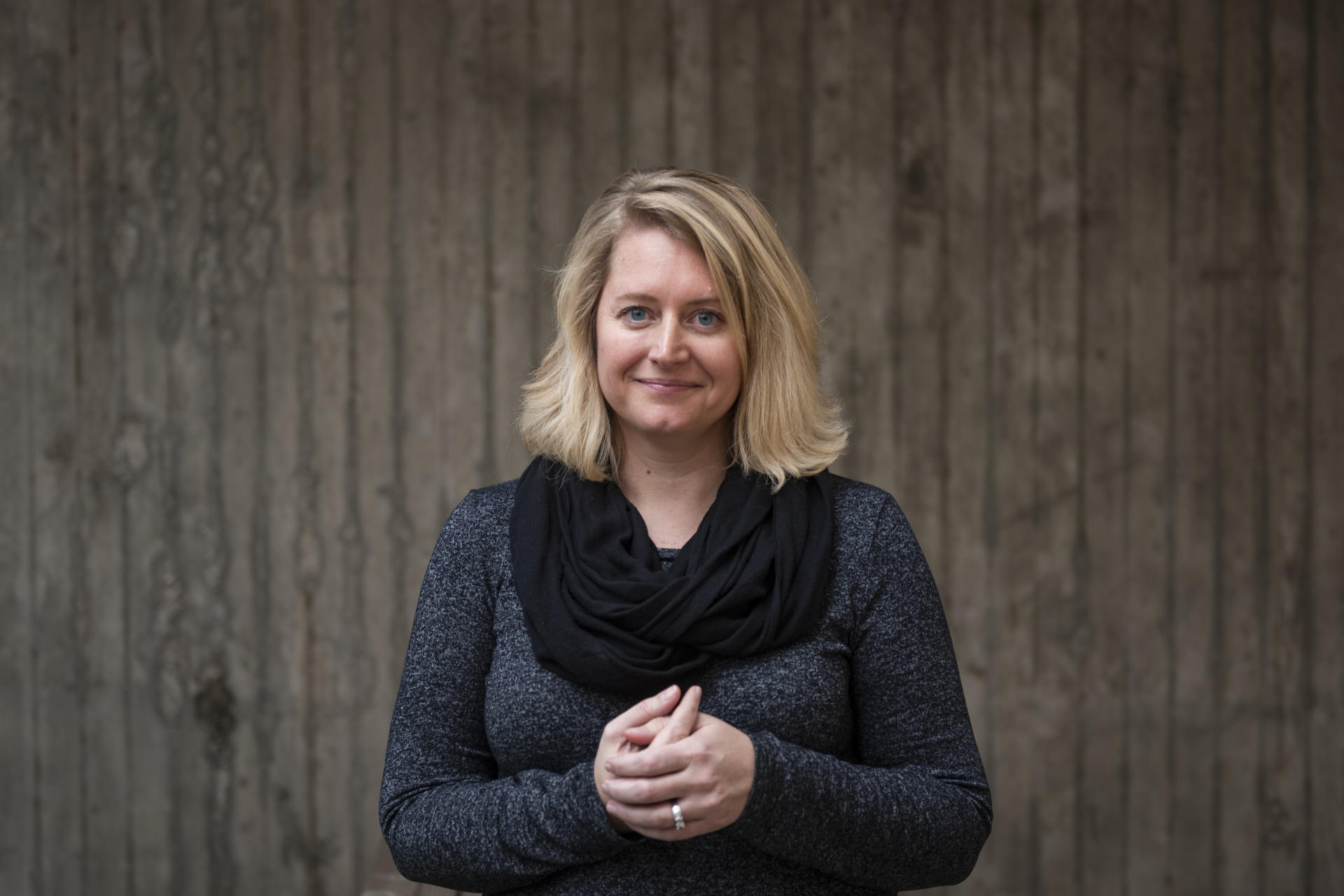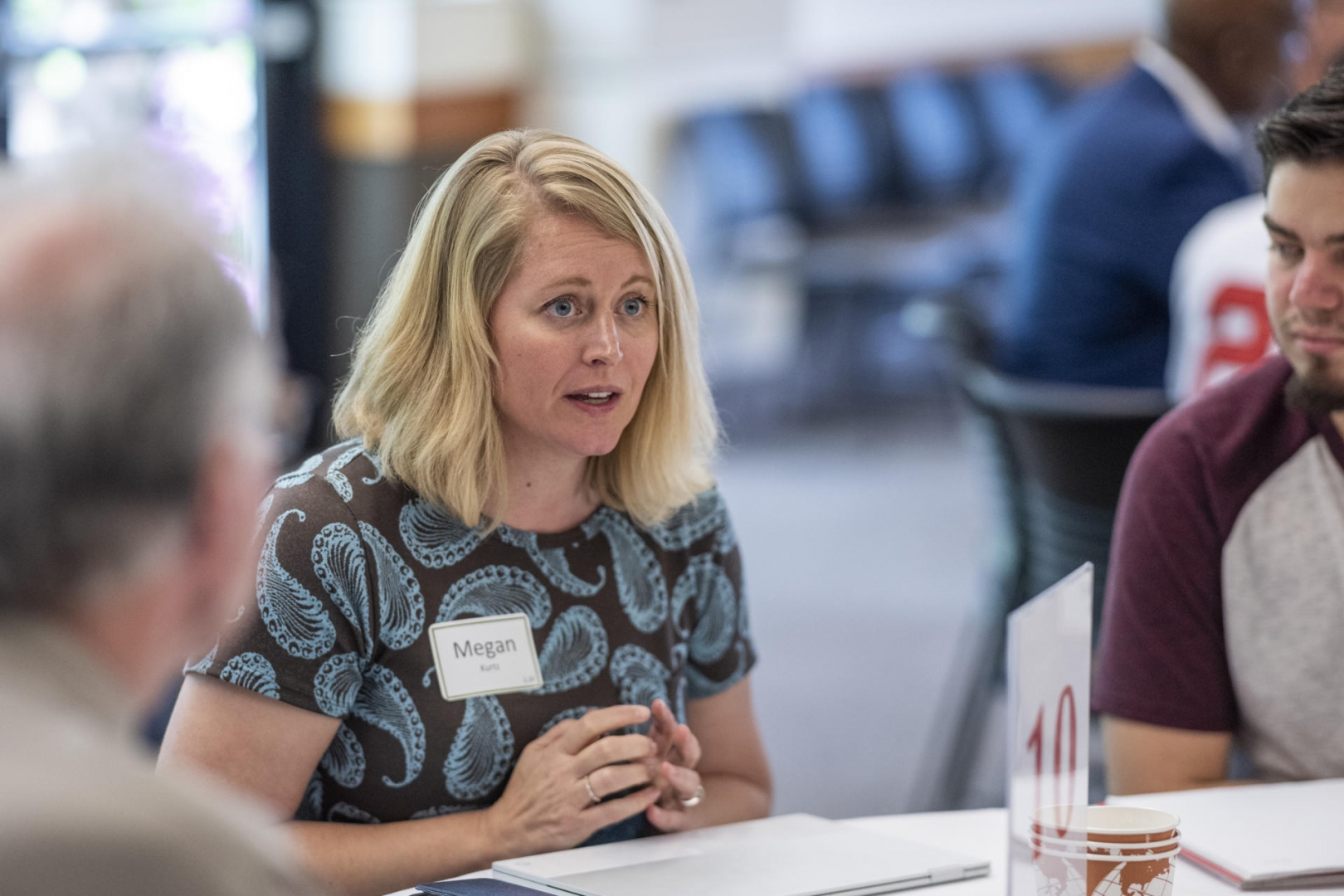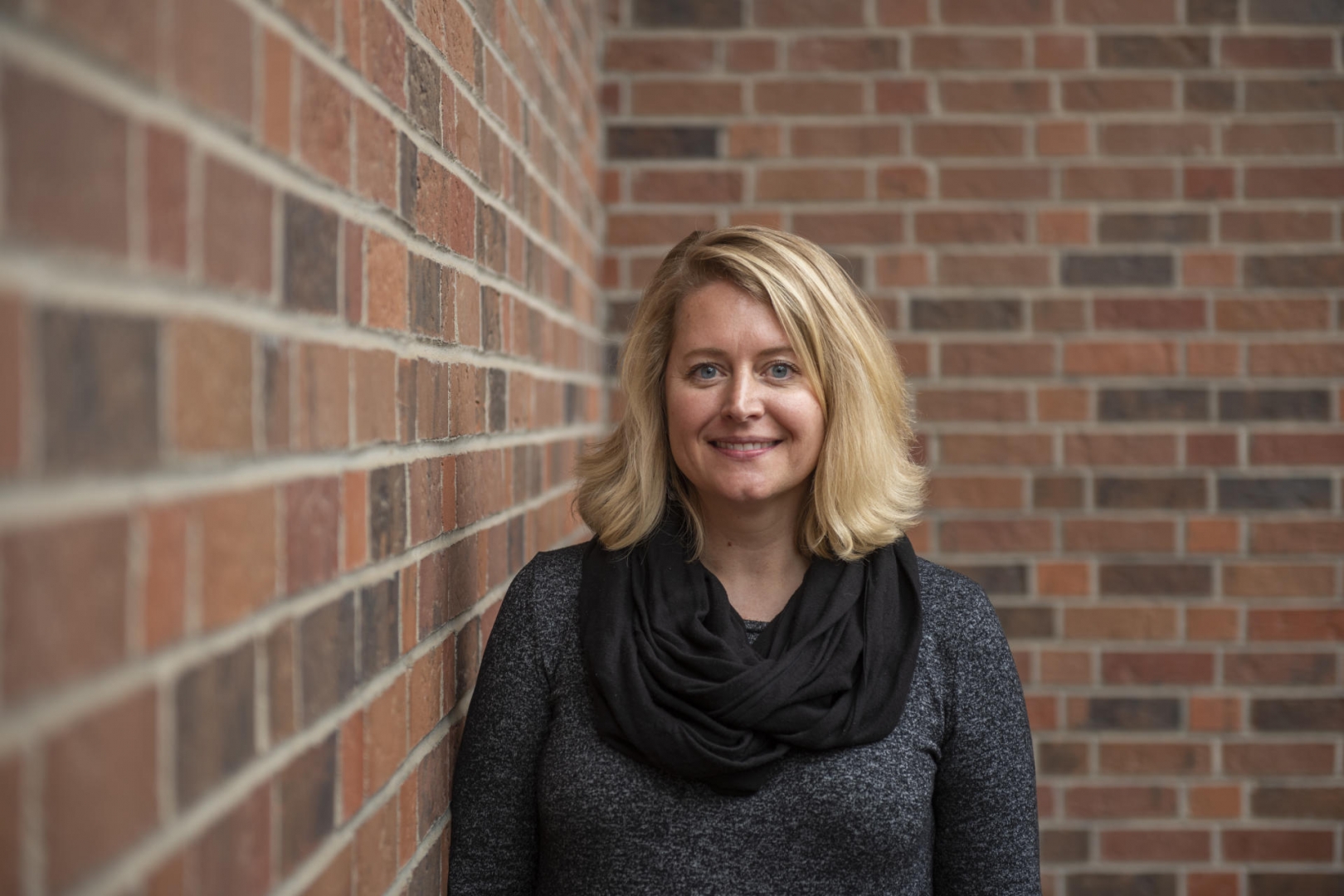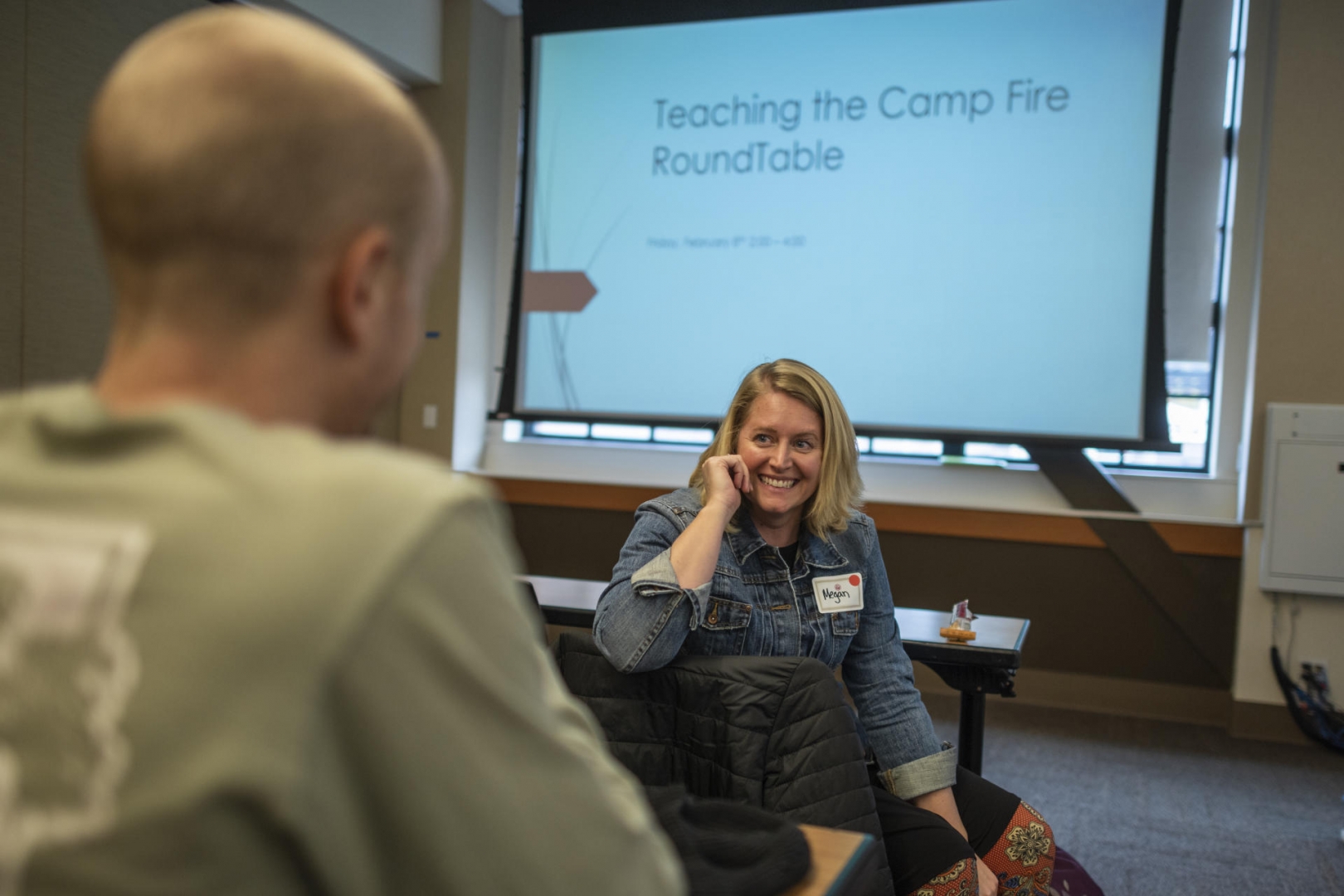Faculty Member Leads as Camp Fire Liaison

Megan Kurtz is on the Board of Directors of the Camp Fire Long Term Recovery Group and is well situated to serve as the Wildcats Rise Community Liaison, photographed on Tuesday, March 5, 2019 in Chico, Calif. (Jason Halley/University Photographer/CSU Chico)
Long before the flames were fully extinguished, the picture of the Camp Fire’s devastation was already sharply in focus.
Reality would only become more jarring in the months to come. As we now know, the impacts were catastrophic: Cal Fire reported the blaze destroyed nearly 19,000 structures—mostly homes but also hundreds of businesses, a handful of public schools, and Feather River Hospital.
The lives of tens of thousands of people across Butte County’s rural foothill communities were immediately uprooted.
Questions naturally followed: What do efforts to rebuild the Ridge look like? Which agencies will and should be part of that lengthy process? And what, if anything, can ultimately be learned?
Those are questions faculty member Megan Kurtz grapples with every day.
“It’s huge. It takes vision and strategic thinking with care for people at the heart of it all,” Kurtz said. “It is difficult work, but it is in the points of frustration that opportunities for new ideas are born.”

From the very beginning, Chico State was committed to Camp Fire relief and recovery, from supporting first responders to establishing the Wildcats Rise Fire Recovery Fund that provided financial assistance to impacted campus community members. Despite the fact that rebuilding Paradise will take years—perhaps decades—it quickly became clear that the University had a vital role supporting the community’s recovery.
Kurtz, a lecturer in the Department of Recreation, Hospitality, and Parks Management, enthusiastically accepted the role of Wildcats Rise Community Liaison in January. She now represents Chico State on the executive board of the Camp Fire Long Term Recovery Group, joining other community representatives and government officials in the work to support the rebuilding process and help Ridge residents navigate the potentially vexing, cumbersome, and frustrating path for answers.
“It was essential to have someone from the University at the table when discussions on rebuilding and recovery were taking place,” said Chico State President Gayle Hutchinson. “The University wanted someone with compassion, diplomacy, and understanding to be a good neighbor, assist with educational opportunities, represent Ridge residents, and coordinate the University’s collaborative efforts. For us, Megan is that person.”
Kurtz (Communication Studies, ’04; MA, Education, ’12) and her husband lived in Magalia for three years in the mid-2000s. Her personal understanding of everyday life in the foothills communities has made it easier to bridge connections with current residents.
“They know that I get what it was like to travel through Paradise on a daily basis,” she said.
She continues to feel a powerful appreciation from the residents when they realize she’s representing the University as a major partner.
“They’re so happy when I introduce myself from Chico State,” she said. “They feel valued, that an academic institution is seeing them, and that it’s worth the time to show up.”
Ridge residents lost so much—their homes, their community, their sense of stability—and are burdened by the resulting vulnerability. No matter how well-intended, when outside agencies come forward with offers to rebuild, to study, and to educate, there’s an understandable sense of skepticism and wariness.
Establishing Chico State as a partner early in the process has gone a long way to building trust with residents, Kurtz said.
“By being a good neighbor and showing up to the meetings and holding space for them, they know it’s ok to be vulnerable with that good neighbor, because we’re not going to judge you later on down the road,” she said.
Much of Kurtz’s role is to represent Camp Fire victims the best way she knows how—and that also includes knowing who’s visiting the burn area and why.

Institutions around the country—from Cal Poly San Luis Obispo and the University of California, Davis to Michigan State, Oregon Tech, and Purdue University—are using the Camp Fire as a teaching and learning opportunity. This alone could keep Kurtz busy, balancing educational opportunities with the neighborhoods’ integrity and privacy and trying to ensure they don’t inflict unintended additional trauma.
“I’m not a checkpoint, because they all have academic freedom,” she said. “But I am there to be hospitable, welcome them to the area, and to say, ‘Here are the ethics we’re also working around.’”
Then, there’s dark tourism, a natural curiosity to visit an area associated with tragedy and death. While Kurtz said there’s nothing inherently wrong with that interest, she stresses to outsiders that the areas are still neighborhoods with meaningful memories, where people fell in love, and watched their families grow and thrive. In short, this is where people lived—and are still living—their lives.
While it may be educational for outsiders to gain a deeper understanding of the event’s historical significance, she works to convey that it can be incredibly painful for those at the heart of the tragedy to feel they are a spectacle. Finding a balance between those is a daily challenge.
“It’s a very sobering thing,” Kurtz said.
While she has embraced her new role, Kurtz continues teaching and has equally welcomed the chance to fold the Camp Fire and its valuable lessons into her own courses.
She said when she discusses it and learning opportunities with her recreation students, they’re riveted. For example, when Paradise middle school students didn’t have a field where they could have recess or run a track meet, Kurtz encouraged her students to get creative with alternatives—and to have fun with it.
Her students have also helped in other ways. Recreation, hospitality, and parks management major Haley MacPhail accompanied Kurtz at a community meeting with Urban Design Associates and listened to discussions of what a rebuilt and reimagined Paradise would look like. MacPhail, a graduating senior, received unique experience she never would have received sitting in a classroom, while also seeing firsthand what these conversations meant to the Ridge.
“It was incredible to see the community come together and how people cared about where they lived,” said MacPhail, a Santa Rosa native whose family’s home was damage in the 2017 Tubbs Fire.

MacPhail added that she’s been inspired watching Kurtz not only pour time and energy into the community liaison role but also to be excited about it.
“Megan is one of those people that the world needs,” MacPhail said. “Someone who cares about everyone and anyone she interacts with, someone who would drop everything to help her community, friends, and family. I am and always will be truly inspired and grateful that I had a professor like her in my life.”
Meanwhile, Kurtz and faculty member Susan Roll continue to lead campus discussions about how the University can and should teach and research the Camp Fire in an ethical and cross-disciplinary fashion. A major teaching component is acknowledging that today’s elementary school children who lived through the Camp Fire may very well be tomorrow’s Chico State Wildcats.
“We need to make sure that their K–12 experience as a Butte County kid is healthy enough so that when they get to us, they can succeed at college—that we know, as staff and faculty, what it means to have a Camp Fire survivor with that traumatic experience in your classroom,” Kurtz said.
She remains confident that the future of Paradise and surrounding communities will include neighborhoods, churches, parks, and stores. But she’s also well aware that the years-long timeline of any rebuilding will mandate the pace.
When looking at her work as a community liaison, her heart goes to the families who dream of one day returning to their homes.
“While we’re being optimistic and looking forward in developing the Ridge and working with the contractors, we need to stay mindful of where this all comes from,” Kurtz said. “That’s where the deep importance lies. This is an actual thing, it’s not just an academic lesson or a service-learning project. It’s real life.”


